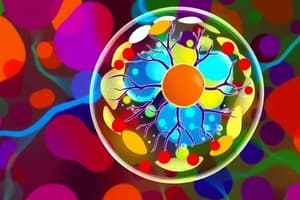Podcast
Questions and Answers
Which process does not directly require oxygen?
Which process does not directly require oxygen?
- Krebs cycle
- Electron transport chain
- Oxidative phosphorylation
- Glycolysis (correct)
Where does the Krebs cycle take place in eukaryotic cells?
Where does the Krebs cycle take place in eukaryotic cells?
- Cytoplasm
- Inner mitochondrial membrane
- Mitochondrial matrix (correct)
- Intermembrane space
What is the main purpose of cellular respiration?
What is the main purpose of cellular respiration?
- To produce carbon dioxide
- To produce glucose
- To produce oxygen
- To produce ATP (correct)
What is the primary role of the cell wall in plant cells?
What is the primary role of the cell wall in plant cells?
Which organelle is responsible for protein synthesis?
Which organelle is responsible for protein synthesis?
Which of the following is an example of diffusion?
Which of the following is an example of diffusion?
What type of transport requires energy to move molecules against their concentration gradient?
What type of transport requires energy to move molecules against their concentration gradient?
Which cell structure is responsible for generating most of the cell's energy?
Which cell structure is responsible for generating most of the cell's energy?
What is the function of the Golgi apparatus?
What is the function of the Golgi apparatus?
Which of the following is found in plant cells but not in animal cells?
Which of the following is found in plant cells but not in animal cells?
What is the net gain of ATP molecules from glycolysis?
What is the net gain of ATP molecules from glycolysis?
What does osmosis refer to?
What does osmosis refer to?
Which of these molecules is broken down to release energy during respiration?
Which of these molecules is broken down to release energy during respiration?
Which of the following is NOT a primary component of the cell membrane?
Which of the following is NOT a primary component of the cell membrane?
What is the primary function of lysosomes?
What is the primary function of lysosomes?
What protects a plant cell?
What protects a plant cell?
What is the process where cells move water from high concentration to low concentration?
What is the process where cells move water from high concentration to low concentration?
What is the name of the process where living cells produce ATP?
What is the name of the process where living cells produce ATP?
Which organelle below is present in animal cells?
Which organelle below is present in animal cells?
Which process does NOT involve the movement of materials across the cell membrane?
Which process does NOT involve the movement of materials across the cell membrane?
Flashcards
What is Glycolysis?
What is Glycolysis?
The breakdown of glucose that doesn't directly need oxygen.
What is the mitochondrial matrix?
What is the mitochondrial matrix?
The location in eukaryotic cells where the Krebs cycle occurs.
What is the main purpose of cellular respiration?
What is the main purpose of cellular respiration?
To produce ATP, the energy currency of the cell.
What is the role of the cell wall?
What is the role of the cell wall?
Signup and view all the flashcards
What is the Ribosome?
What is the Ribosome?
Signup and view all the flashcards
What is Diffusion?
What is Diffusion?
Signup and view all the flashcards
What is Active transport?
What is Active transport?
Signup and view all the flashcards
What is the Mitochondrion?
What is the Mitochondrion?
Signup and view all the flashcards
What is the Golgi apparatus?
What is the Golgi apparatus?
Signup and view all the flashcards
What is the Cell Wall?
What is the Cell Wall?
Signup and view all the flashcards
What is the net ATP gain from glycolysis?
What is the net ATP gain from glycolysis?
Signup and view all the flashcards
What is Osmosis?
What is Osmosis?
Signup and view all the flashcards
What is Glucose?
What is Glucose?
Signup and view all the flashcards
What are Nucleic acids?
What are Nucleic acids?
Signup and view all the flashcards
What are Lysosomes?
What are Lysosomes?
Signup and view all the flashcards
What is the Cell Wall?
What is the Cell Wall?
Signup and view all the flashcards
What is Osmosis?
What is Osmosis?
Signup and view all the flashcards
What is Cellular respiration?
What is Cellular respiration?
Signup and view all the flashcards
What are Centrioles?
What are Centrioles?
Signup and view all the flashcards
What is Replication?
What is Replication?
Signup and view all the flashcards




